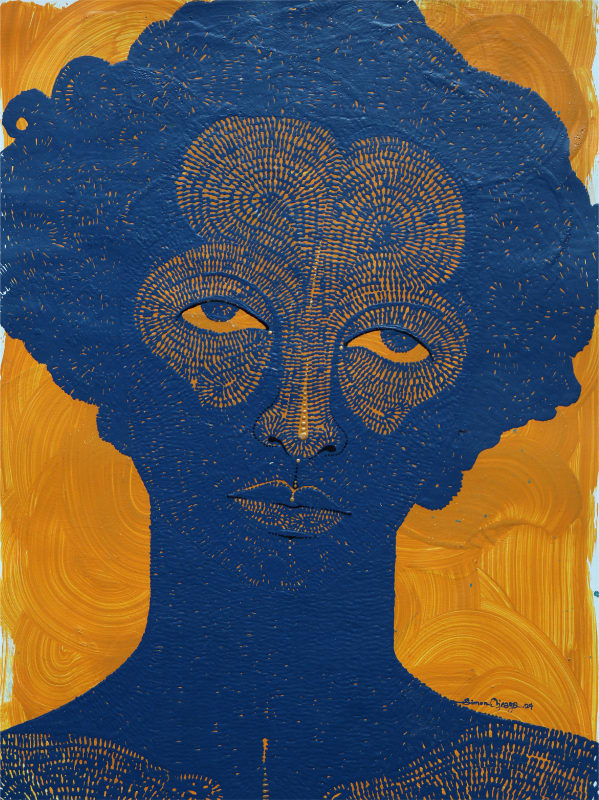Black figuration is not over. It is not redundant. It is not a phase. It is a living language—one that refuses silence and insists on presence, on imagination, on becoming.
In an age where the visual field is oversaturated, the ongoing prominence of figuration in Black and African art stands not as aesthetic repetition, but as an urgent political and cultural gesture—a reclaiming of presence, history, and imaginative sovereignty.
Portraiture has long occupied a central space in African and Black artistic traditions. Whether through ancestral sculpture, mural painting, or photography, the impulse to depict the self and the community has never been incidental—it reflects the value we place on kinship, legacy, and relational identity. Figuration, then, is not merely about likeness, but about memory, ritual, and resistance. It is a language deeply rooted in cultural continuity and spiritual function.
In contemporary practice, Black figuration continues to evolve. It moves beyond visibility to agency; beyond representation to reinvention. At a moment when some voices in the art world claim that “Black portraiture is over,” we must ask: for whom? This declaration too often masks a desire to erase Black presence once again—rendering our bodies, our dreams, and our pain invisible under the guise of novelty fatigue. This exhibition responds to that impulse directly. It insists on our right to be seen, on our own terms, in all our emotional and conceptual complexity.
The artists in this show work across a spectrum of media—sculpture, painting, photography, collage, digital and mixed media—but are united in their pursuit of figuration as a living, adaptable tool. Here, Blackness is not pinned to realism alone. It stretches into abstraction, surrealism, fragmentation, and the speculative. It refuses confinement.
Reuben Ugbine and Djakou Kassi Nathalie embody the enduring power of sculpture in African art. Ugbine draws from West African spiritual iconography, creating tactile forms that collapse time—rooted in ancestral memory yet speaking to contemporary themes. Djakou’s work fuses African symbols with surrealist influences, reshaping the sculptural form into emotional and conceptual statements. Their practices confirm that sculpture remains a vital mode of cultural transmission and transformation.
Mobolaji Ogunrosoye, Orry Studio, and Lakin Ogunbanwo challenge the stability of the photographic image. For them, the photograph is not an endpoint but a raw material to be cut, burned, painted, transferred, and layered. Mobolaji’s multi-dimensional layered collages speak to archival memory, feminine identity, and bodily reconstruction. Orry Shenjobi, working between photography and painting, uses photographic transfer and hand-augmented canvas to blur realism with introspective abstraction. Ogunbanwo, widely known for his clean studio portraiture, engages collage more minimally but no less conceptually—fragmenting the gaze and reimagining the African subject beyond static representation. Collectively, these artists offer an introspective counterpoint to the historical objectification of African bodies in photography.
Anthony Nsofor, Isaac Emokpae, and Joseph Ogbeide draw a conceptual through-line to the legacy of Uli, the indigenous Igbo art form popularised in modernist terms by the Nsukka Group. For Nsofor, line becomes both mark and metaphor—an instrument through which to unravel memory, diaspora, and colonial residue. Emokpae brings emotional weight to his layered, often ambiguous figures, using duality—closeness and distance, love and conflict—as a lens to explore family, legacy, and psychological depth. Ogbeide’s mastery of negative space gives his works an architectural tension; his figures emerge through absence, invoking ancestral presence and cultural dislocation. Together, these artists use abstraction not to obscure the figure but to evoke its deeper truths—emotional, cultural, historical.
The Afro-surrealists—Soji Adesina, Chika Idu, and Olajide Ajayi (LA Draws)—use visual estrangement to reimagine Black subjectivity beyond the limits of realism. Adesina’s impasto-rich canvases depict morphing, dreamlike bodies in flux—both grounded and transcendent. Chika Idu’s new portraits, seemingly illuminated by screen light, quietly question the psychological toll of hyperconnectivity. Ajayi renders elongated, otherworldly Black forms, his gestural linework invokes dreamlike vulnerability—eyes downcast, bodies merging with plants or cosmic space—evoking both cultural rootedness and surreal transcendence. Though less visible in major galleries yet, Ajayi’s rising presence on social platforms underscores Afro-surrealism’s link to young Black imaginative expression. These artists do not merely depict Blackness—they speculate it, stretch it, mystify and reframe it. Afro-surrealism here becomes a tool of decolonial imagination.
Taiye Idahor and Stephen Price explore the politics of place and inheritance through symbolic figuration and atmospheric environments. Idahor’s continued use of hair ties the contemporary Black female experience to historical memory and spiritual lineage. Her newer works imagine oases of rest—gesturing toward emancipation while acknowledging the burden that remains. Price’s paintings feel suspended between presence and disappearance—layered, quiet, yet emotionally charged. Both artists engage abstraction as a way to convey not what the body looks like, but what it carries.
In Simon Ojeaga’s “fractellations,” figuration is built stroke by stroke—each line a frequency, a pulse, a ritual. His compositions blur figure and ground, self and system, creating an affective visual language that feels more whispered than shouted. His works resonate with the soundscape of Yinka Bernie, the alté musician whose soulful, lo-fi sonic world shares Ojeaga’s sensitivity to interiority, slowness, and spiritual calm. One feels what the other sounds like.
Finally, Opeyemi Olukotun offers a counterpoint—his portraits, unflinchingly realist, insist on emotional specificity and social intimacy. He paints not just what people look like but what it feels like to be them—market women, bikers, immigrants—figures too often erased from visual culture. His work is a reminder that realism, when handled with empathy, is still a radical act.
Together, these artists reject the idea that figuration is exhausted. They assert that to see and be seen—to witness oneself and one’s community through one’s own lens—is not passé, but essential. They speak in forms that bend, blur, and bloom, but never disappear.
Black figuration is not over. It is not redundant. It is not a phase. It is a living language—one that refuses silence and insists on presence, on imagination, on becoming.
This exhibition is a declaration:
Black figuration is alive and well.
Obida Obioha














